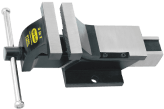A woodworking vice consists of two jaws for holding a workpiece and its screw mechanism is used to open and close those jaws. The name woodworking vice is given to a heavy-duty clamping vice that is assembled with a workbench. It can be used to perform heavy-duty tasks as its strong metal construction and jaws allow it to withstand large amounts of force during work applications.
Table of Contents
ToggleWhat is a Woodworkers Vice?
A woodworking vise is also known as a woodworker’s vice. It has two jaws, one is fixed and the other is movable. A movable jaw can be moved by turning a screw attached to a handle. Turn the handle of the vise in a clockwise direction and the movable jaws are moved towards the fixed jaw. To move away the movable jaw from the fixed jaw, you need to turn the handle counterclockwise.
What is a Vice Used for in Woodwork?
As the name implies, woodworking vices are used for all the things mentioned below:
- gluing
- sawing
- planing
- chipping
- chiseling
- engraving
- marking
- measuring
A woodworking vice is used for either heavy-duty or light work as it can hold both small or large workpieces of wood. Because of its clamping abilities, it is usually used by professional woodworkers and in manufacturing industries for wood products production, such as veneers, plywood, flooring, containers, etc.
How to Install a Woodworking Vice to a Workbench?
When you decide to mount a woodworking vice to a bench, make sure to do it safely. The following are steps followed to install a woodworking vice to a workbench:
Choose worktop
When using a vice, always keep the fixed body securely linked to a robust workstation, such as a woodworking bench. The workbench should be securely secured to the floor as well.
Place a vice
Before bolting, make sure the vice is in the optimal position. When mounting a woodworking vice, make sure the upper edge of the jaws is level with the workbench surface. At this point, make sure there is adequate room for the entire length of the screw when the vice’s jaws are fully closed.
Drill bolt holes
Mark out the holes where the vice will be bolted after positioning it optimally. These holes must then be bored in order for the bolts to pass through the worktop.
Bolt vice
Next, insert bolts into all of the mounting bracket’s holes. To increase security, insert lock washers between the bolts and the mounting bracket to disperse the fastener’s load. This is how to fit a woodworking vice to a bench.
How to Make a Woodworking Vice?
Making a woodworking vice from scratch can be a challenging project, as it involves working with metal components and precision machining. However, if you have the necessary skills and access to the right tools and materials, you can follow these general steps to create a basic woodworking vice:
Materials and Tools You’ll Need:
- Steel or iron stock for the vice components (jaw, screw, handle)
- Wooden blocks for the jaws
- Welding equipment
- Metal cutting tools (angle grinder, hacksaw, or bandsaw)
- Bench drill press
- Taps and dies for threading
- Bench vise for holding parts during fabrication
- Woodworking tools for shaping the wooden jaws
- Screws and nuts for assembly
- Protective gear (safety glasses, gloves, welding helmet, etc.)
Step-by-Step Instructions:
- Design the Vice
Decide on the size and capacity of your woodworking vice. Sketch out a design that includes the dimensions of the jaws, screw, and handle.
- Prepare the Steel/Iron Stock
Cut the steel or iron stock into the desired lengths and shapes for the vice components. You’ll need a fixed jaw, a moving jaw, a threaded screw, and a handle.
- Fabricate the Jaws
Shape the steel or iron pieces for the jaws using a bench grinder or other metalworking tools. Ensure that the jaws have parallel faces to grip the workpiece effectively. Drill holes in the jaws for mounting them to the bench.
- Create the Screw and Handle
Cut and thread a steel or iron rod to make the vice screw. You’ll need to use a lathe or thread-cutting tool for this step. Create a handle for the vice screw, which can be a simple cylindrical piece with a tapped hole to attach it to the screw.
- Assemble the Vice
Attach the fixed jaw to your workbench using screws or bolts. Thread the vice screw through the fixed jaw and into the moving jaw. Attach the handle to the end of the vice screw. Ensure that the vice operates smoothly and securely grips workpieces.
- Create Wooden Jaw Faces
Cut and shape wooden blocks to serve as the jaw faces. These should be slightly wider and taller than the steel jaws. Attach the wooden jaw faces to the steel jaws using screws or glue.
- Finish the Vice
Paint or finish the steel components to protect them from rust and corrosion. Sand and finish the wooden jaw faces to make them smooth and resistant to wear. Moreover, despite manufacturing vices on your own, you can buy workbenches with vices for your workshop.
Conclusion
You can buy a woodworking vice if you want something to hold the object so you can perform different operations. To buy the best woodworking vice for your workshop, you can contact Ajay Tools.


